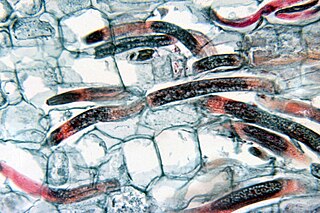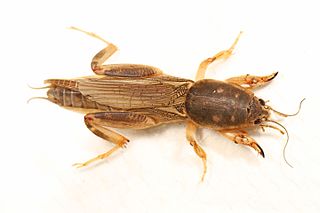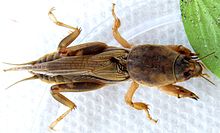
Mole crickets are members of the insect family Gryllotalpidae, in the order Orthoptera. Mole crickets are cylindrical-bodied, fossorial insects about 3–5 cm (1.2–2.0 in) long as adults, with small eyes and shovel-like fore limbs highly developed for burrowing. They are present in many parts of the world and where they have arrived in new regions, may become agricultural pests.

Root-knot nematodes are plant-parasitic nematodes from the genus Meloidogyne. They exist in soil in areas with hot climates or short winters. About 2000 plants worldwide are susceptible to infection by root-knot nematodes and they cause approximately 5% of global crop loss. Root-knot nematode larvae infect plant roots, causing the development of root-knot galls that drain the plant's photosynthate and nutrients. Infection of young plants may be lethal, while infection of mature plants causes decreased yield.

Radopholus similis is a species of nematode known commonly as the burrowing nematode. It is a parasite of plants, and it is a pest of many agricultural crops. It is an especially important pest of bananas, and it can be found on coconut, avocado, coffee, sugarcane, other grasses, and ornamentals. It is a migratory endoparasite of roots, causing lesions that form cankers. Infected plants experience malnutrition.

Heterorhabditis is a genus of nematodes belonging to the order Rhabditida. All species of this genus are obligate parasites of insects, and some are used as biological control agents for the control of pest insects.

Entomopathogenic nematodes (EPN) are a group of nematodes, that cause death to insects. The term entomopathogenic has a Greek origin, with entomon, meaning insect, and pathogenic, which means causing disease. They are animals that occupy a bio control middle ground between microbial pathogens and predator/parasitoids. Although many other parasitic thread worms cause diseases in living organisms, entomopathogenic nematodes are specific in only infecting insects. Entomopathogenic nematodes (EPNs) live parasitically inside the infected insect host, and so they are termed as endoparasitic. They infect many different types of insects living in the soil like the larval forms of moths, butterflies, flies and beetles as well as adult forms of beetles, grasshoppers and crickets. EPNs have been found all over the world in a range of ecologically diverse habitats. They are highly diverse, complex and specialized. The most commonly studied entomopathogenic nematodes are those that can be used in the biological control of harmful insects, the members of Steinernematidae and Heterorhabditidae. They are the only insect-parasitic nematodes possessing an optimal balance of biological control attributes.

The Sciaridae are a family of flies, commonly known as dark-winged fungus gnats. Commonly found in moist environments, they are known to be a pest of mushroom farms and are commonly found in household plant pots. This is one of the least studied of the large Diptera families, probably due to the small size of these insects and the similarity among species.

Rotylenchulus reniformis, the reniform nematode, is a species of parasitic nematode of plants with a worldwide distribution in the tropical and subtropical regions.
Pratylenchus brachyurus is a plant parasitic nematode.

Paratylenchus hamatus, the fig pin nematode, is a species of migratory plant endoparasites, that causes lesions on plant roots resulting in symptoms of chlorosis, wilting and ultimately yield losses. They move and feed on different parts of host tissue throughout their life cycle in order to find enough susceptible host tissue to survive and reproduce. A wide range of host plant species are susceptible to the fig pin nematode, including many valuable fruit and vegetable crops such as figs, carrots and celery. They are also commonly found associated with woody perennials in California. P. hamatus inhabits soils in both Europe and North America, and was originally isolated from fig in central California in 1950.

The nematodes, roundworms or eelworms constitute the phylum Nematoda. They are a diverse animal phylum inhabiting a broad range of environments. Most species are free-living, feeding on microorganisms, but there are many that are parasitic. The parasitic worms (helminths) are the cause of soil-transmitted helminthiases.

Scapteriscus is a genus of insects in the family Gryllotalpidae, the mole crickets. Members of the genus are called two-clawed mole crickets. They are native to South America. Some species have arrived in other regions, including parts of North America, where some have become invasive and have become established as pests.
Ormia depleta, sometimes called the Brazilian red-eyed fly, is a species of fly in the family Tachinidae. It is a parasitoid of mole crickets in the genus Scapteriscus. It is native to South America but has been imported into the United States and elsewhere as a biological pest control agent.

Neoscapteriscus vicinus, commonly known as the tawny mole cricket, is a species of insect in the mole cricket family, Gryllotalpidae. This species is native to South America and also occurs in the Southern United States, where it arrived as a contaminant of ship's ballast around 1900. Colombian insect taxonomist Oscar Cadena-Castañeda studied specimens of the genus which had been called Scapteriscus, and decided that it included two groups; a smaller group and a larger group that he named Neoscapteriscus in 2015. North American mole cricket taxonomists agreed with his decision and altered Orthoptera Species File Online accordingly.
Neoscapteriscus abbreviatus, the short-winged mole cricket, is a species of insect in the mole cricket family, Gryllotalpidae. It is native to South America but has been introduced inadvertently into Florida, in the United States. Unlike other related species, it is unable to fly, nor do the males emit songs in order to attract females.

Steinernema carpocapsae is an entomopathogenic nematode and a member of the family Steinernematidae. It is a parasitic roundworm that has evolved an insect-killing symbiosis with bacteria, and kills its hosts within a few days of infection. This parasite releases its bacterial symbiont along with a variety of proteins into the host after infection, and together the bacteria and nematode overcome host immunity and kill the host quickly. As a consequence, S. carpocapsae has been widely adapted for use as a biological control agent in agriculture and pest control. S. carpocapsae is considered a generalist parasite and has been effectively used to control a variety of insects including: Webworms, cutworms, armyworms, girdlers, some weevils, and wood-borers. This species is an example of an "ambush" forager, standing on its tail in an upright position near the soil surface and attaching to passing hosts, even capable of jumping. As an ambush forager, S. carpocapsae is thought to be especially effective when applied against highly mobile surface-adapted insects. S. carpocapsae can sense carbon dioxide production, making the spiracles a key portal of entry into its insect hosts. It is most effective at temperatures ranging from 22–28 °C (72–82 °F).

Neoscapteriscus borellii, the southern mole cricket, is a species of insect in the family Gryllotalpidae.

Steinernema is a genus of nematodes in the family of Steinernematidae. The genus Steinernema is named after the nematologist Gotthold Steiner.
Steinernema xueshanense is a nematode species from the genus of Steinernema. Steinernema xueshanense is named after the Xue Shan mountains.

Howardula is a genus of nematode that infests the larvae of mushroom-feeding flies, beetles, and other insects. Various Howardula species and strains infest mushroom-feeding Drosophila, including Howardula aoronymphium and Howardula neocosmis. Howardula husseyi can infest the mushroom phorid Megaselia halterata.
Necromeny is a symbiotic relationship where an animal infects a host and waits inside its body until its death, at which point it develops and completes its life-cycle on the cadaver, feeding on the decaying matter and the subsequent bacterial growth. As the necromenic animal benefits from the relationship while the host is unharmed, it is an example of commensalism.












